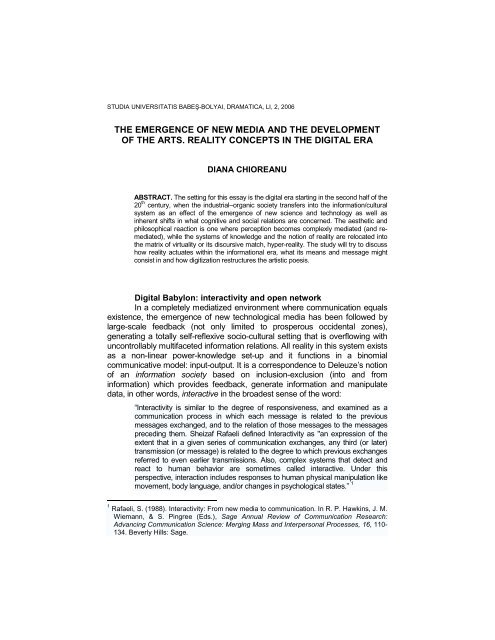studia universitatis babeÅ â bolyai dramatica teatru, film, media 2
studia universitatis babeÅ â bolyai dramatica teatru, film, media 2
studia universitatis babeÅ â bolyai dramatica teatru, film, media 2
You also want an ePaper? Increase the reach of your titles
YUMPU automatically turns print PDFs into web optimized ePapers that Google loves.
STUDIA UNIVERSITATIS BABEŞ-BOLYAI, DRAMATICA, LI, 2, 2006<br />
THE EMERGENCE OF NEW MEDIA AND THE DEVELOPMENT<br />
OF THE ARTS. REALITY CONCEPTS IN THE DIGITAL ERA<br />
DIANA CHIOREANU<br />
ABSTRACT. The setting for this essay is the digital era starting in the second half of the<br />
20 th century, when the industrial–organic society transfers into the information/cultural<br />
system as an effect of the emergence of new science and technology as well as<br />
inherent shifts in what cognitive and social relations are concerned. The aesthetic and<br />
philosophical reaction is one where perception becomes complexly <strong>media</strong>ted (and re<strong>media</strong>ted),<br />
while the systems of knowledge and the notion of reality are relocated into<br />
the matrix of virtuality or its discursive match, hyper-reality. The study will try to discuss<br />
how reality actuates within the informational era, what its means and message might<br />
consist in and how digitization restructures the artistic poesis.<br />
Digital Babylon: interactivity and open network<br />
In a completely <strong>media</strong>tized environment where communication equals<br />
existence, the emergence of new technological <strong>media</strong> has been followed by<br />
large-scale feedback (not only limited to prosperous occidental zones),<br />
generating a totally self-reflexive socio-cultural setting that is overflowing with<br />
uncontrollably multifaceted information relations. All reality in this system exists<br />
as a non-linear power-knowledge set-up and it functions in a binomial<br />
communicative model: input-output. It is a correspondence to Deleuze’s notion<br />
of an information society based on inclusion-exclusion (into and from<br />
information) which provides feedback, generate information and manipulate<br />
data, in other words, interactive in the broadest sense of the word:<br />
“Interactivity is similar to the degree of responsiveness, and examined as a<br />
communication process in which each message is related to the previous<br />
messages exchanged, and to the relation of those messages to the messages<br />
preceding them. Sheizaf Rafaeli defined Interactivity as "an expression of the<br />
extent that in a given series of communication exchanges, any third (or later)<br />
transmission (or message) is related to the degree to which previous exchanges<br />
referred to even earlier transmissions. Also, complex systems that detect and<br />
react to human behavior are sometimes called interactive. Under this<br />
perspective, interaction includes responses to human physical manipulation like<br />
movement, body language, and/or changes in psychological states.” 1<br />
1 Rafaeli, S. (1988). Interactivity: From new <strong>media</strong> to communication. In R. P. Hawkins, J. M.<br />
Wiemann, & S. Pingree (Eds.), Sage Annual Review of Communication Research:<br />
Advancing Communication Science: Merging Mass and Interpersonal Processes, 16, 110-<br />
134. Beverly Hills: Sage.

















